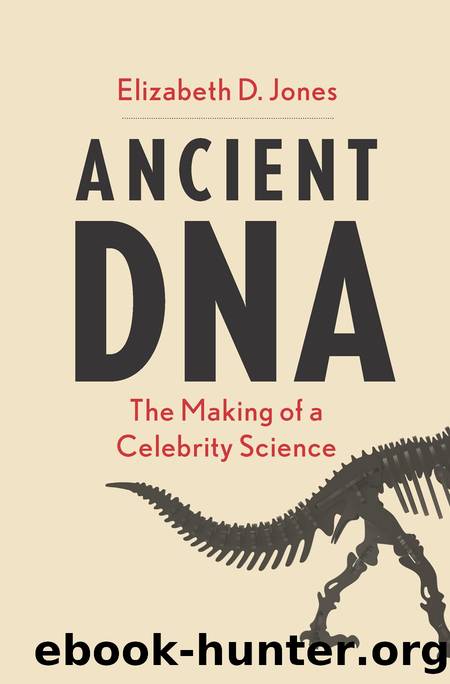Ancient DNA by Elizabeth D Jones

Author:Elizabeth D Jones
Language: eng
Format: epub
ISBN: 9780300240122
Publisher: Yale University Press
GENOME REVOLUTION
The search for ancient genomes, facilitated by the technical convenience of NGS and its ability to produce genomic data quickly and relatively cheaply, has ushered in a race among researchers to be the first to sequence whole genomes from a variety of specimens including ancient plants, animals, and diseases. Some researchers have also set their sights on recovering genomic information from ancient humans including Paleo-Eskimos, Aboriginal Australians, and famous historical figures like King Richard III.39 In the search for ancient human genomes, scientists have used this data to shed light on the behavior of our early ancestors, including Mesolithic and Neolithic hunter-gatherers, while also exploring transformations in human cultural practices such as milk consumption, which have directly impacted our evolution in terms of selection for lactase persistence.40 Much work has examined our interactions with animals through time by interrogating genetic signals for domestication in pigs, cattle, and dogs on large global and temporal scales.41 Using NGS, scientists are seeking to reach farther back in time to learn more about our extinct and archaic ancestor the Neanderthal. With this genome-wide data, scientists were able to estimate the extent to which early humans and Neanderthals had interbred before the latterâs extinction.42 Adding to the excitement, practitioners sequenced the first genomic data from a Denisovan, a formerly unknown extinct hominin species whose identity as a distinct archaic human species was uniquely obtained from DNA extracted from a small finger bone, as no extensive fossil record exists.43 According to scientists and journalists, these worksâamong othersârepresent a revolution in our understanding of human history in terms of our origin, evolution, and migration across the globe.44
For some scientists, this adaptation of high-throughput sequencing technologies to the search for DNA from fossils, and the massive amount of data that could be produced from it, as well as the resulting grandiose conclusions that researchers could draw from it, suggested an overcoming of previous limitations and a maturation of the field. At the same time, however, the field seemed to be coming full circle, back to an era of exploration and hype. This race for the first or the oldest genome (as well as the race to sequence the most genomes), and the accompanying media attention surrounding these high-profile publications in Nature and Science, shared striking similarities to the search in the 1990s for the first or oldest DNA. In one way, this hype took form through scientistsâ newfound confidence not only in the technology of NGS to generate a higher quality and quantity of genomic data from ancient specimens but also in their ability to overcome previous contamination concerns. In another way, hype also took form through scientistsââas well as media reportersââprojections that the field had come of age and into a new role as an authority on human evolutionary history as told through DNA. As ancient DNA researchers explored the potential afforded by next-generation sequencing technologies, these two kinds of hype colored the direction of the discipline and the publicâs perception of it.
Although the introduction of
Download
This site does not store any files on its server. We only index and link to content provided by other sites. Please contact the content providers to delete copyright contents if any and email us, we'll remove relevant links or contents immediately.
Sapiens: A Brief History of Humankind by Yuval Noah Harari(14252)
The Tidewater Tales by John Barth(12608)
Mastermind: How to Think Like Sherlock Holmes by Maria Konnikova(7227)
Do No Harm Stories of Life, Death and Brain Surgery by Henry Marsh(6890)
The Thirst by Nesbo Jo(6826)
Why We Sleep: Unlocking the Power of Sleep and Dreams by Matthew Walker(6618)
Life 3.0: Being Human in the Age of Artificial Intelligence by Tegmark Max(5474)
Sapiens by Yuval Noah Harari(5294)
The Longevity Diet by Valter Longo(5019)
The Body: A Guide for Occupants by Bill Bryson(4974)
The Rules Do Not Apply by Ariel Levy(4861)
The Immortal Life of Henrietta Lacks by Rebecca Skloot(4525)
Animal Frequency by Melissa Alvarez(4395)
Why We Sleep by Matthew Walker(4360)
The Hacking of the American Mind by Robert H. Lustig(4318)
Yoga Anatomy by Kaminoff Leslie(4305)
All Creatures Great and Small by James Herriot(4232)
Double Down (Diary of a Wimpy Kid Book 11) by Jeff Kinney(4207)
Barron's AP Biology by Goldberg M.S. Deborah T(4097)
